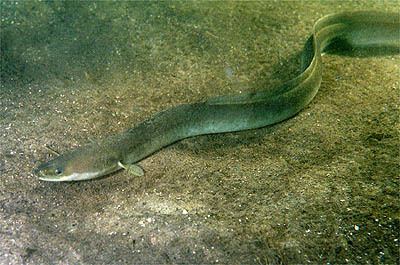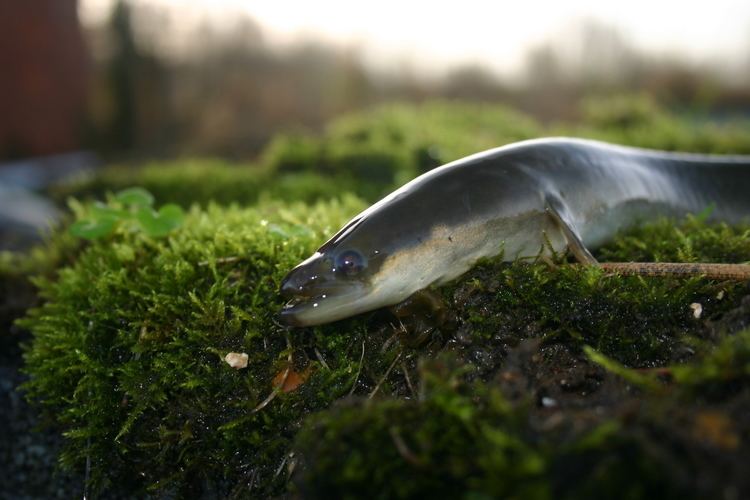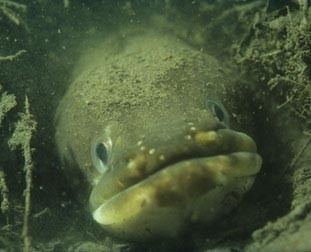Order Anguilliformes Genus Anguilla Scientific name Anguilla anguilla Length 60 – 80 cm (Adult) Found in Loch Ness, Lake Constance | Phylum Chordata Species A. anguilla Mass 3.6 kg (Adult) Higher classification Anguillidae | |
 | ||
Conservation status Critically Endangered (Population decreasing) Similar Zander, Northern pike, Tench, Atlantic salmon, Eel | ||
The amazing life cycle of the european eel
The European eel (Anguilla anguilla) is a species of eel, a snake-like, catadromous fish. They can reach a length of 1.5 m (4 ft 11 in) in exceptional cases, but are normally around 60–80 cm (2.0–2.6 ft), and rarely reach more than 1 m (3 ft 3 in). While captive specimens have lived over 85 years in captivity, the species' lifespan in the wild has not been determined.
Contents
- The amazing life cycle of the european eel
- European eel anguilla anguilla moving from puddle into creek
- Life history
- Conservation status
- Sustainable consumption
- Decreasing population numbers and breeding projects
- References

European eel anguilla anguilla moving from puddle into creek
Life history
Much of the European eel’s life history was a mystery for centuries, as fishermen never caught anything they could identify as a young eel. Unlike many other migrating fish, eels begin their life cycle in the ocean and spend most of their lives in fresh inland water, or brackish coastal water, returning to the ocean to spawn and then die. In the early 1900s, Danish researcher Johannes Schmidt identified the Sargasso Sea as the most likely spawning grounds for European eels. The larvae (leptocephali) drift towards Europe in a 300-day migration. When approaching the European coast, the larvae metamorphose into a transparent larval stage called "glass eel", enter estuaries, and many start migrating upstream. After entering their continental habitat, the glass eels metamorphose into elvers, miniature versions of the adult eels. As the eel grows, it becomes known as a "yellow eel" due to the brownish-yellow color of their sides and belly. After 5–20 years in fresh or brackish water, the eels become sexually mature, their eyes grow larger, their flanks become silver, and their bellies white in color. In this stage, the eels are known as "silver eels", and they begin their migration back to the Sargasso Sea to spawn.
Conservation status

The European eel is a critically endangered species. Since the 1970s, the numbers of eels reaching Europe is thought to have declined by around 90% (possibly even 98%). Contributing factors include overfishing, parasites such as Anguillicola crassus, barriers to migration such as hydroelectric dams, and natural changes in the North Atlantic oscillation, Gulf Stream, and North Atlantic drift. Recent work suggests polychlorinated biphenyl pollution may be a factor in the decline.

Eels have been important sources of food both as adults (including the famous jellied eels of East London) and as glass eels. Glass-eel fishing using basket traps has been of significant economic value in many river estuaries on the western seaboard of Europe.

In captivity, European eels can live for very long times. According to a report in The Local, a specimen lived 155 years in the well of a family home in Brantevik, a fishing village in southern Sweden.
Sustainable consumption

In 2010, Greenpeace International added the European eel to its seafood red list. In 2010 The Sustainable Eel Group launched the Sustainable Eel Standard.
Decreasing population numbers and breeding projects
As the European eel population has been falling for some time, a project started by Innovatie Netwerk (nl) is researching whether it is possible to breed European eels in captivity. Breeding the European eel is difficult because eels are generally only able to reproduce after having swum a distance of 6,500 km (4,000 mi). In the project, the swimming distance is being simulated by means of a type of swimming machine for the fish. Innovatie Netwerk has also started a breeding project, called InnoFisk Volendam.
